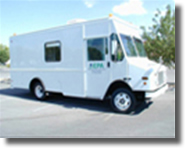Monitoring For Environmental Radiation
Emergency Preparedness
and Response
Since the mid-1900s, domestic and foreign weapons tests, accidents, and other radiological events have released radioactive material into the environment. One of EPA's primary roles during and after these events is to monitor the surrounding environment for radiation and radionuclides.
In response to actual emergencies, such as Chernobyl, or potential emergencies, such as the launch or re-entry of nuclear powered satellites, EPA sends specially trained staff to help protect people and the environment. Monitoring allows us to track known releases and to watch for contaminants when there is a potential for release.
On this page:
- How does EPA monitor for and track radiation releases?
- How long has EPA monitored for large-scale environmental radiation contamination?
- What do the monitoring data show?
- Where can I see RadNet monitoring data?
How does EPA monitor for and track radiation releases?
EPA monitors and tracks radiation releases in two ways:
- monitoring equipment brought to the scene of an incident by our Radiological Emergency Response Team (RERT) is used to look for localized radiation
- RadNet EPA's nationwide monitoring system, which monitors the environment on an on-going basis, is used to monitor larger-scale releases of radioactive material.
Looking for Localized Radiation Threats
RERT's specialized equipment is specifically selected for use in detecting localized radiation in various situations.
-
Hand-held equipment can be used at sites where radiation is believed to exist – this equipment is primarily used to measure contamination levels that may threaten the safety of responders or the public.
-
Most of the RERT’s equipment is designed to focus on identifying and assessing potential impacts of low-level contamination – contamination that may present a long-term threat to the public or the environment, but probably isn’t an immediate hazard. Towards this end, the RERT has air samplers that can be placed away from the immediate incident, where lower levels of contamination may be found.

- Mobile sample preparation trailers and mobile laboratories are used by EPA to determine whether low-level contamination exists in samples taken from the environment around a site. RERT has two Mobile Environmental Radiation Laboratories (MERLs), which can arrive at any site in the United States within two to four days.
- EPA’s scanner van is one of many pieces of specialized equipment that can be used to detect radiation. It can be driven around a large area to identify “hotspots” where radiological contamination or other threats may exist. These vehicles contain the latest radiation survey and communications equipment and are maintained in a constant state of readiness for deployment at a moment's notice.

Identifying Large-Scale Contamination: RadNet
EPA’s RadNet is constantly in operation, with station operators nationwide taking periodic samples of media where radionuclides are likely to be present:
- air
- drinking water
- precipitation
- milk.
Samples for testing come from a complex network of sampling stations across the nation that has grown from the earliest program (Radiation Alert Network) begun in 1956 to monitor for fallout and deposition from above-ground nuclear weapons tests. The current name, Radnet, replaces the earlier 'Environmental Radiation Ambient Monitoring System' (ERAMS). Renaming of the system marks its increased importance, reconfiguration, and an expansion of the number of monitoring sites.
How long has EPA monitored for large-scale environmental radiation contamination?
RadNet and its predecessors have been collecting data since 1956. The current system was formed by combining several existing monitoring systems. You can see both the history of radiation monitoring and the nuclear events that RadNet and its predecessors tracked in the Radiological Events and Monitoring Timeline.(This link leads out of the Radiation Protection Web site; use the 'back' button to return.)
What do the monitoring data show?
Historical data from RadNet's predecessor, ERAMS, show the rise of environmental radiation during nuclear incidents and its decline as the fallout decays. Since the end of above ground nuclear weapons testing, the day-to-day readings from monitoring sites have fallen. Now, and for many years, analysis of typical samples shows risk levels far below regulatory limits. In fact, results are now generally below levels that instruments can detect.
Data from any significant release, such as Chernobyl, show a clear difference against the day-to-day or background levels RadNet normally detects. By plotting results from sampling stations across the nation, we can determine and track the path of the contaminant plume.
Where can I see RadNet monitoring data?
Much of the data collected is available online through EPA's Envirofacts/(RadNet) Database. (This link leads away from the Radiation Protection Web site; use your browser's back button to return.) The system allows users to do a basic query by any one or all of several parameters:
- location
- media
- nuclide/radiation
- date range.
A customized query is also available for more advanced users. A users' guide, which describes the system and how to use it, is also available.
In addition, you can view reports complied from the data collected by RadNet and its predecessors at Environmental Radiation Data. (This link leads away from the Radiation Protection Web site; use your browser's back button to return.)
![[logo] US EPA](https://webarchive.library.unt.edu/eot2008/20081013193819im_/http://www.epa.gov/epafiles/images/logo_epaseal.gif)